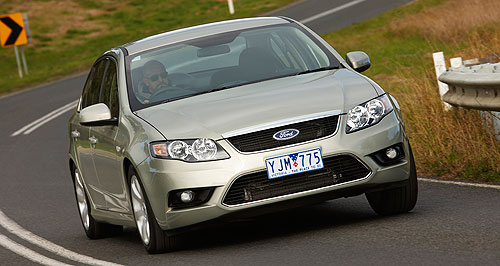Make / Model Search
News - General News - FuelsGas subsidy slides into history with $600m billAll that gas: Federal government subsidies for Ford Falcon (left) and Holden Commodore LPG models switch off today, and appear to have done little to bolster sales of the more hip-pocket friendly cars. LPG conversion rebate scheme closes a seven-year chapter1 Jul 2014 By BARRY PARK A FEDERAL government scheme to encourage more private buyers to jump behind the wheel of LPG-fuelled cars officially winds up today, having done little to bolster the fortunes of local car-makers. After seven years and more than 317,000 grants paid out worth almost $600 million, the scheme that rewards motorists who convert a pre-owned car with $2000 cash-back, and those that buy one out of the showroom with a $1000 payment, has handed Ford and Holden – the only two local car-makers to offer cars converted to run on LPG – fewer than 390 sales a year. Instead, the subsidy has spawned a healthy LPG conversion industry that even now struggles with the legacy of buyers regarding it as a cheap but smelly taxi fuel rather than a serious alternative to petrol- and diesel-powered cars. According to the official government statistics, over its lifetime the scheme has approved 3629 grants for brand-new cars converted to run on LPG, including vehicles that were bought new but converted to run on LPG before they left the showroom. However, according to official VFACTS sales data, only about 2700 privately owned LPG cars have been registered since the scheme’s introduction in August 2006, falling well short of the government’s estimate. Holden’s base-model dedicated LPG Commodore Evoque is priced from $37,490, and carries a big premium over the entry-level petrol-powered Evoque, which starts from $34,990 before on-road costs. However, the less-powerful LPG-powered variant gains the larger 3.6-litre V6 engine, and while the official combined fuel use on the gas is higher at 11.5L/100km compared with the petrol-powered 3.0-litre V6 version’s 8.3L/100km, the carbon dioxide emissions are much lower for the LPG-fuelled version at 185g/km compared with 198g/km for the petrol one. Likewise, the version of Ford’s Falcon converted to run the 4.0-litre in-line six on LPG is priced from $39,735 compared with $37,235 for the petrol-powered version. However, because the Ford version of the system uses liquid, rather than gas injection to the engine, the LPG-fuelled engine is more powerful than the petrol version, with fuel use rated at 12.3L/100km and emissions at 199g/km, compared with the petrol motor’s 9.9L/100km average and 236g/km. Both these cars are trumped by the turbocharged 2.0-litre four-cylinder EcoBoost version of the Falcon, which costs the same as the six-cylinder version, but cuts fuel use and emissions to 8.1L/100km and 192g/km. Both Ford and Holden told GoAuto that they would continue to offer the LPG models as part of the Falcon and Commodore line-up despite the subsidy’s withdrawal. Ford and Holden both declined to say how many LPG variants they were selling each month. The Victorian government is currently investigating if the skills of Ford, Holden and Toyota workers can convert into a much broader LPG conversion industry based in the state.  Read more |
Click to shareGeneral News articlesResearch General News Motor industry news |












Facebook Twitter Instagram